The AMD Ryzen 9 3950X Review: 16 Cores on 7nm with PCIe 4.0
by Dr. Ian Cutress on November 14, 2019 9:00 AM ESTCPU Performance: Web and Legacy Tests
While more the focus of low-end and small form factor systems, web-based benchmarks are notoriously difficult to standardize. Modern web browsers are frequently updated, with no recourse to disable those updates, and as such there is difficulty in keeping a common platform. The fast paced nature of browser development means that version numbers (and performance) can change from week to week. Despite this, web tests are often a good measure of user experience: a lot of what most office work is today revolves around web applications, particularly email and office apps, but also interfaces and development environments. Our web tests include some of the industry standard tests, as well as a few popular but older tests.
We have also included our legacy benchmarks in this section, representing a stack of older code for popular benchmarks.
All of our benchmark results can also be found in our benchmark engine, Bench.
WebXPRT 3: Modern Real-World Web Tasks, including AI
The company behind the XPRT test suites, Principled Technologies, has recently released the latest web-test, and rather than attach a year to the name have just called it ‘3’. This latest test (as we started the suite) has built upon and developed the ethos of previous tests: user interaction, office compute, graph generation, list sorting, HTML5, image manipulation, and even goes as far as some AI testing.
For our benchmark, we run the standard test which goes through the benchmark list seven times and provides a final result. We run this standard test four times, and take an average.
Users can access the WebXPRT test at http://principledtechnologies.com/benchmarkxprt/webxprt/
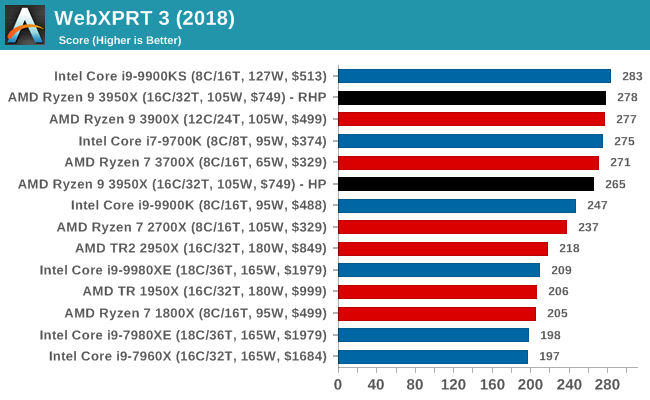
WebXPRT 2015: HTML5 and Javascript Web UX Testing
The older version of WebXPRT is the 2015 edition, which focuses on a slightly different set of web technologies and frameworks that are in use today. This is still a relevant test, especially for users interacting with not-the-latest web applications in the market, of which there are a lot. Web framework development is often very quick but with high turnover, meaning that frameworks are quickly developed, built-upon, used, and then developers move on to the next, and adjusting an application to a new framework is a difficult arduous task, especially with rapid development cycles. This leaves a lot of applications as ‘fixed-in-time’, and relevant to user experience for many years.
Similar to WebXPRT3, the main benchmark is a sectional run repeated seven times, with a final score. We repeat the whole thing four times, and average those final scores.
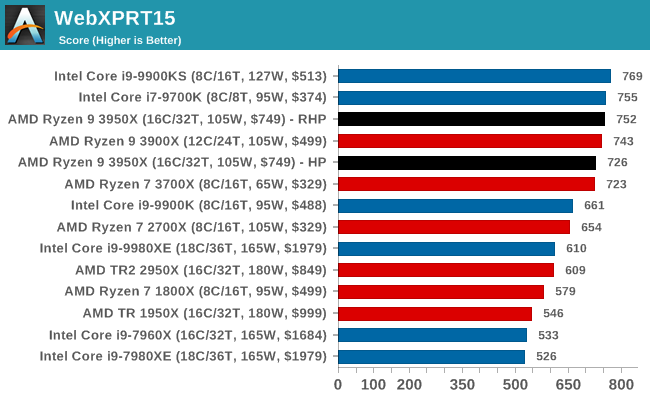
Speedometer 2: JavaScript Frameworks
Our newest web test is Speedometer 2, which is a accrued test over a series of javascript frameworks to do three simple things: built a list, enable each item in the list, and remove the list. All the frameworks implement the same visual cues, but obviously apply them from different coding angles.
Our test goes through the list of frameworks, and produces a final score indicative of ‘rpm’, one of the benchmarks internal metrics. We report this final score.
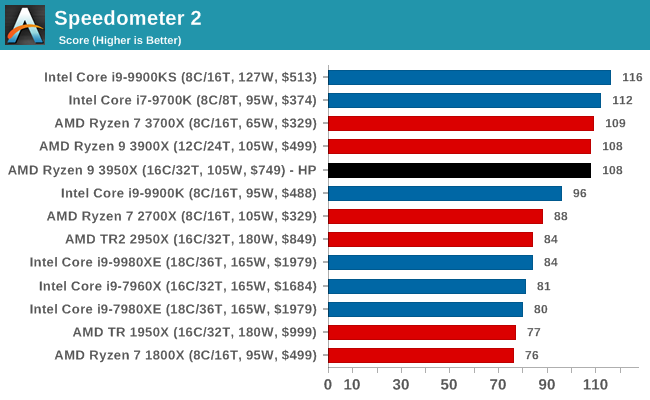
Google Octane 2.0: Core Web Compute
A popular web test for several years, but now no longer being updated, is Octane, developed by Google. Version 2.0 of the test performs the best part of two-dozen compute related tasks, such as regular expressions, cryptography, ray tracing, emulation, and Navier-Stokes physics calculations.
The test gives each sub-test a score and produces a geometric mean of the set as a final result. We run the full benchmark four times, and average the final results.

Mozilla Kraken 1.1: Core Web Compute
Even older than Octane is Kraken, this time developed by Mozilla. This is an older test that does similar computational mechanics, such as audio processing or image filtering. Kraken seems to produce a highly variable result depending on the browser version, as it is a test that is keenly optimized for.
The main benchmark runs through each of the sub-tests ten times and produces an average time to completion for each loop, given in milliseconds. We run the full benchmark four times and take an average of the time taken.

3DPM v1: Naïve Code Variant of 3DPM v2.1
The first legacy test in the suite is the first version of our 3DPM benchmark. This is the ultimate naïve version of the code, as if it was written by scientist with no knowledge of how computer hardware, compilers, or optimization works (which in fact, it was at the start). This represents a large body of scientific simulation out in the wild, where getting the answer is more important than it being fast (getting a result in 4 days is acceptable if it’s correct, rather than sending someone away for a year to learn to code and getting the result in 5 minutes).
In this version, the only real optimization was in the compiler flags (-O2, -fp:fast), compiling it in release mode, and enabling OpenMP in the main compute loops. The loops were not configured for function size, and one of the key slowdowns is false sharing in the cache. It also has long dependency chains based on the random number generation, which leads to relatively poor performance on specific compute microarchitectures.
3DPM v1 can be downloaded with our 3DPM v2 code here: 3DPMv2.1.rar (13.0 MB)
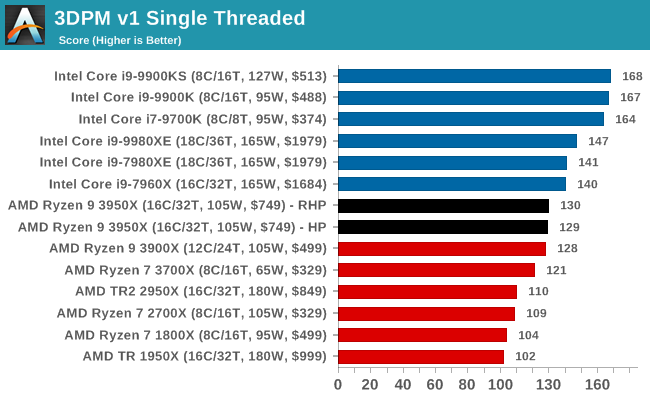
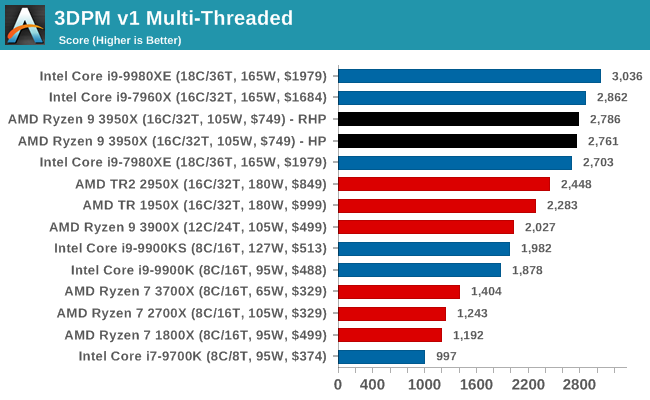
x264 HD 3.0: Older Transcode Test
This transcoding test is super old, and was used by Anand back in the day of Pentium 4 and Athlon II processors. Here a standardized 720p video is transcoded with a two-pass conversion, with the benchmark showing the frames-per-second of each pass. This benchmark is single-threaded, and between some micro-architectures we seem to actually hit an instructions-per-clock wall.
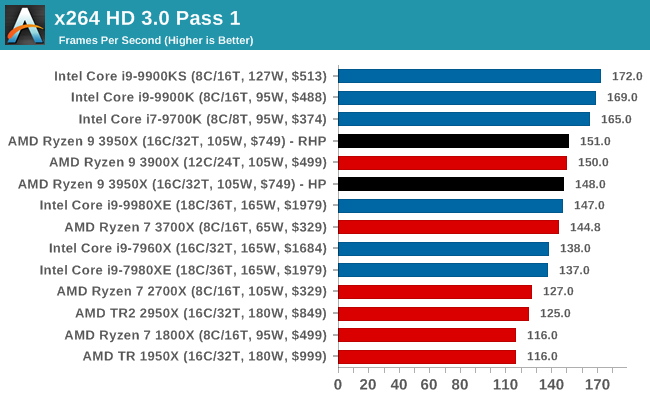
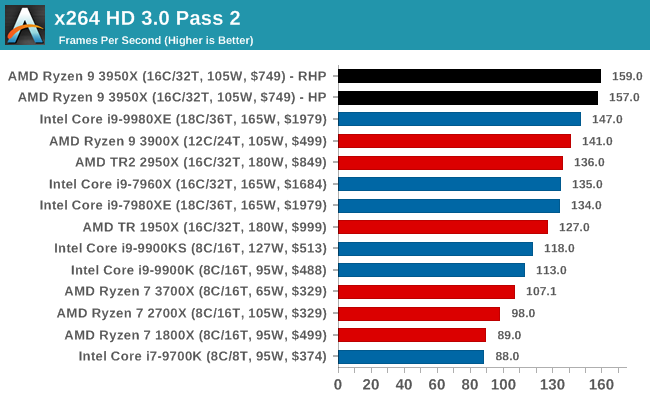
GeekBench4: Synthetics
A common tool for cross-platform testing between mobile, PC, and Mac, GeekBench 4 is an ultimate exercise in synthetic testing across a range of algorithms looking for peak throughput. Tests include encryption, compression, fast Fourier transform, memory operations, n-body physics, matrix operations, histogram manipulation, and HTML parsing.
I’m including this test due to popular demand, although the results do come across as overly synthetic, and a lot of users often put a lot of weight behind the test due to the fact that it is compiled across different platforms (although with different compilers).
We record the main subtest scores (Crypto, Integer, Floating Point, Memory) in our benchmark database, but for the review we post the overall single and multi-threaded results.

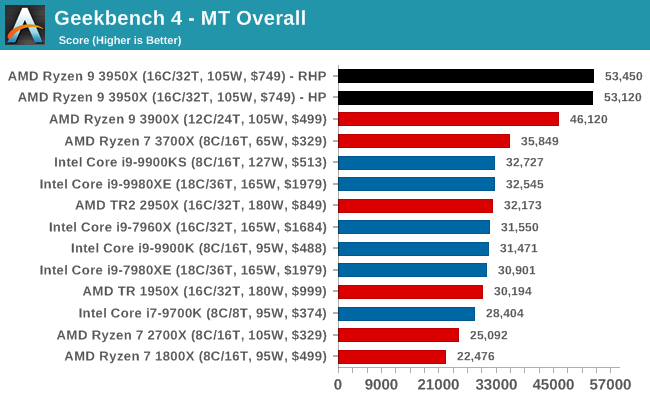










206 Comments
View All Comments
drunkenmaster - Thursday, November 14, 2019 - link
That's not really how it works. 10nm for Intel is struggling for clock speed and yields but more importantly the architecture remains fairly close to the same overall. What architecture gains they made they appear to be losing in clock speed.The only really big advantage AMD has from 7nm TSMC, aside from also lower clocks, is die size. They can fit 16 cores into a die size that Intel can, but can't easily. Frankly the only direct benefit Intel will get from 10nm is the fact that a similar 16 core chip would hopefully use the same power as AMDs, though with the way their 10nm is working due to poor yields and lacking clock speeds they would likely up the voltage to push clock speeds as high as possible and well, there is a reason their 10/12 core stuff isn't coming out on 10nm any time soon.
AMD gained performance on architecture but they were already close to this competitive with their 8 core 14nm chip (a worse than Intel 14nm node). As with what Intel would gain, AMD gained in performance/watt and die size, the actual competitiveness of their chips is purely due to being a competitive architecture. Intel won't magically destroy them, they'll be in the same ballpark.
This is the thing people have been kind of weird about, a year ago Zen 1 wasn't far behind Intel on a significantly worse '14nm' node that was more like a lets say 18nm node and Intel had the best 14nm node by a mile. While AMD have a headstart on better nodes when Intel gets to 10nm it's only in the same ballpark as TSMC 7nm. Even when Intel finally make the leap they are only gaining parity with TSMC, not an advantage and their architectural advantage is not really there. With Icelake the only 'win' is AVX512, which is basically unused for the home market.
10nm won't enable Intel to destroy anyone, if their 10nm started working well it would enable them to drop to similar power usage as AMD and offer similar core counts in the same die sizes, the architectures are close enough that the chips would be pretty damn close in overall performance.
Though that's assuming Intel managed a 16 core with a ringbus which is one of the major reasons for it's competitiveness in areas like gaming. If they have to go to a mesh for 16 core then they lose that advantage.
Spunjji - Thursday, November 14, 2019 - link
Solid assessment. Thanks for the post :)lobz - Thursday, November 14, 2019 - link
My dear friend, intel's 10nm chips will not be superior in performance, because they can't hit either the same core count or the frequency needed to let the high IPC matter. Also, by the time intel's 7nm comes out, AMD will have a better than the current process and an even faster architecture. We're speaking at least 2 years from now. Destroy AMD's chips? Good luck.drothgery - Thursday, November 14, 2019 - link
Except at the highest core counts (on the desktop, HEDT, and server), Intel has much more of a pricing problem with Ryzen than a performance problem.Phynaz - Thursday, November 14, 2019 - link
I would say AMD has the pricing problem, as Intel sets their own price, where AMD has to react to intel.Death666Angel - Friday, November 15, 2019 - link
Intel: "We just decided to drop the 10xxx HEDT pricing by 50% or so. No reaction to any of our competitors. Totally our own decision. Move along, nothing to see here." I get that.Qasar - Saturday, November 16, 2019 - link
intel sets its own price, maybe before, but not now. as Death666Angel said, intel didn't drop the price of its 10xx series cpus cause they were being nice, it was because they can't charge that much any more.John_M - Monday, November 25, 2019 - link
That's such a dumb argument. If course they'll be competitive on price if they are priced to compete! You can say that about anything. The sentence reduces to nothing.AIV - Thursday, November 14, 2019 - link
Market pricing for intel HEDT processors have already halved. eg. i9-9980XE is now available for ~1050EUR. See https://geizhals.eu/intel-core-i9-9980xe-extreme-e... .Jorgp2 - Thursday, November 14, 2019 - link
That's retailers lowering prices to clear stock, has nothing to do with Intel